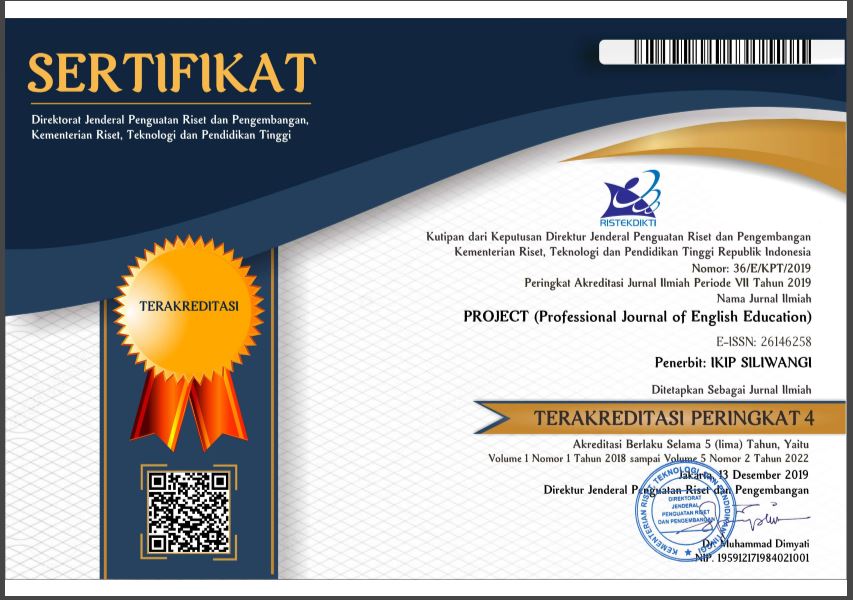AN ERROR ANALYSIS IN WRITING DESCRIPTIVE TEXT OF THE SEVENTH GRADE STUDENTS
DOI:
https://doi.org/10.22460/project.v2i5.p616-621Abstrak
The teaching learning process of English language contentrates on the four skills, those are : listening, reading, speaking and writing. The skills of writing is not only used to test how well students to aquire a second or foreign langauge, but also to express ideas in english writing with reasonable coherence and accuracy is a major objective. However many students still make errors in their writing. The research entitled “An Error Analysis In Writing Descriptive Text Of The Seventh Grade Studentsâ€Â was to analyze the errors in their descriptive text. The purpose of this research were to find out the types of the grammatical errors in writing descriptive text and the dominant type of errors in writing descriptive text. The subject in this research in this research were 10 of seventh grade students of SMP Negeri 2 Batujajar, and used the descriptive qualitative method. The researchers collect the data from the students writing task. The result in this research that are errors were made by students based on the surface strategy taxonomy was four types of the grammatical errors they are Misformation (42 errors = 41,1%), addition (30 errors = 29,5%), misordering (17 errors = 16,6%), and omission (13 errors = 12,8%). It means that dominant type of grammatical errors in this research is misformation.
Referensi
Apsari, Y. (2016). Cloze Passage In Improving Students’reading Comprehension. ELTIN
JOURNAL, Journal of English Language Teaching in Indonesia, 4(2), 53-62.
Apsari, Y. (2017). The Use of Picture Series in Teaching Writing Recount Text. Eltin Journal, Journal Of English Language Teaching In Indonesia, 5(2), 51-56.
Argawati, N. O., & Suryani, L. (2017). Teaching Writing Using Think-Pair-Share Viewed From Students ’ Level Of Risk -Taking. ERJEE, 6(1), 109–116. https://doi.org/10.25134/erjee.v6i1.776.Received
Asrial, R., & Asty, H. (2010). Teaching Writing Descriptive Text by Combining Brainstorming and Y Chart Strategies at Junior High School. 1–8.
Burt, M. K., Dulay, H. C., & Hernandez, E. (1976). Bilingual Syntax Measure. New York: Harcourt Brace Jovanich.
Dulay, H., Burt, M., & Krashen, S. (1982). Language Two (1st ed.). New York: Oxford University Press.
Hasyim, S. (2002). Error Analysis in the Teaching of English. 4(1), 42–50. Retrieved from http://puslit.petra.ac.id/journals/letters
Husna, L., Zainil, & Rozimela, Y. (2013). No Title. 1(2), 1–16.
Maghfuroh, & Nugroho, H. A. (2015). Developing Descriptive Writing Skill By Using Small Group Discussion For Tenth Graders. 1–6.
Mundriyah, M., & Parmawati, A. (2016). Using Think-Pair-Share (Tps) To Improve Students’writing Creativity (A Classroom Action Research In The Second Semester Students Of Stkip Siliwangi Bandung). P2m Stkip Siliwangi, 3(2), 84-91.
Parmawati, A. (2013). The efffectiveness of Think-Pair-Share (TPS) to Teach Writing Viewed From Students Creativity (Doctoral dissertation, SEBELAS MARET UNIVERSITY).
Richards, C. J. (1973). Error Analysis.




